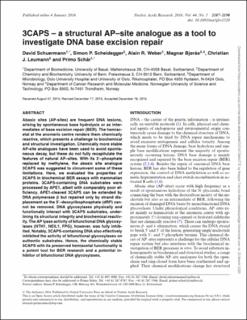| dc.contributor.author | Schürmann, David | |
| dc.contributor.author | Scheidegger, Simon P. | |
| dc.contributor.author | Weber, Alain R. | |
| dc.contributor.author | Bjørås, Magnar | |
| dc.contributor.author | Leumann, Christian J. | |
| dc.contributor.author | Schär, Primo | |
| dc.date.accessioned | 2020-03-26T15:00:31Z | |
| dc.date.available | 2020-03-26T15:00:31Z | |
| dc.date.created | 2016-07-11T12:48:57Z | |
| dc.date.issued | 2016 | |
| dc.identifier.citation | Nucleic Acids Research. 2016, 44 (5), 2187-2198. | en_US |
| dc.identifier.issn | 0305-1048 | |
| dc.identifier.uri | https://hdl.handle.net/11250/2648962 | |
| dc.description.abstract | Abasic sites (AP-sites) are frequent DNA lesions, arising by spontaneous base hydrolysis or as intermediates of base excision repair (BER). The hemiacetal at the anomeric centre renders them chemically reactive, which presents a challenge to biochemical and structural investigation. Chemically more stable AP-site analogues have been used to avoid spontaneous decay, but these do not fully recapitulate the features of natural AP–sites. With its 3′–phosphate replaced by methylene, the abasic site analogue 3CAPS was suggested to circumvent some of these limitations. Here, we evaluated the properties of 3CAPS in biochemical BER assays with mammalian proteins. 3CAPS-containing DNA substrates were processed by APE1, albeit with comparably poor efficiency. APE1-cleaved 3CAPS can be extended by DNA polymerase β but repaired only by strand displacement as the 5′–deoxyribophosphate (dRP) cannot be removed. DNA glycosylases physically and functionally interact with 3CAPS substrates, underlining its structural integrity and biochemical reactivity. The AP lyase activity of bifunctional DNA glycosylases (NTH1, NEIL1, FPG), however, was fully inhibited. Notably, 3CAPS-containing DNA also effectively inhibited the activity of bifunctional glycosylases on authentic substrates. Hence, the chemically stable 3CAPS with its preserved hemiacetal functionality is a potent tool for BER research and a potential inhibitor of bifunctional DNA glycosylases. | en_US |
| dc.language.iso | eng | en_US |
| dc.publisher | Oxford University Press (OUP) | en_US |
| dc.rights | Navngivelse-Ikkekommersiell 4.0 Internasjonal | * |
| dc.rights.uri | http://creativecommons.org/licenses/by-nc/4.0/deed.no | * |
| dc.title | 3CAPS - A structural AP-site analogue as a tool to investigate DNA base excision repair | en_US |
| dc.type | Peer reviewed | en_US |
| dc.type | Journal article | en_US |
| dc.description.version | publishedVersion | en_US |
| dc.source.pagenumber | 2187-2198 | en_US |
| dc.source.volume | 44 | en_US |
| dc.source.journal | Nucleic Acids Research | en_US |
| dc.source.issue | 5 | en_US |
| dc.identifier.doi | 10.1093/nar/gkv1520 | |
| dc.identifier.cristin | 1367416 | |
| dc.description.localcode | C The Author(s) 2016. Published by Oxford University Press on behalf of Nucleic Acids Research. This is an Open Access article distributed under the terms of the Creative Commons Attribution License (http://creativecommons.org/licenses/by-nc/4.0/), which permits non-commercial re-use, distribution, and reproduction in any medium, provided the original work is properly cited. For commercial re-use, please contact journals.permissions@oup.com | en_US |
| cristin.ispublished | true | |
| cristin.fulltext | original | |
| cristin.qualitycode | 2 | |

